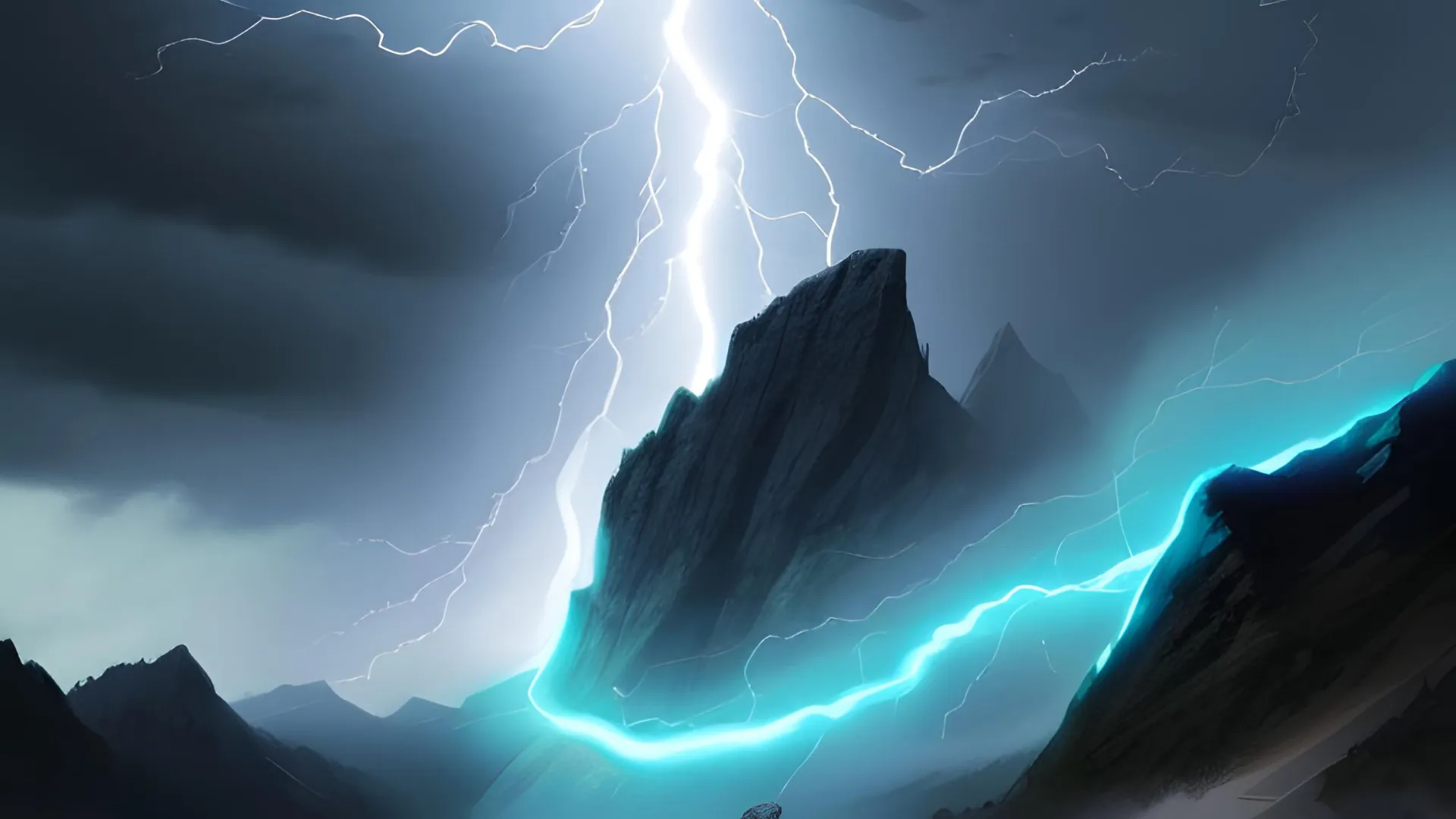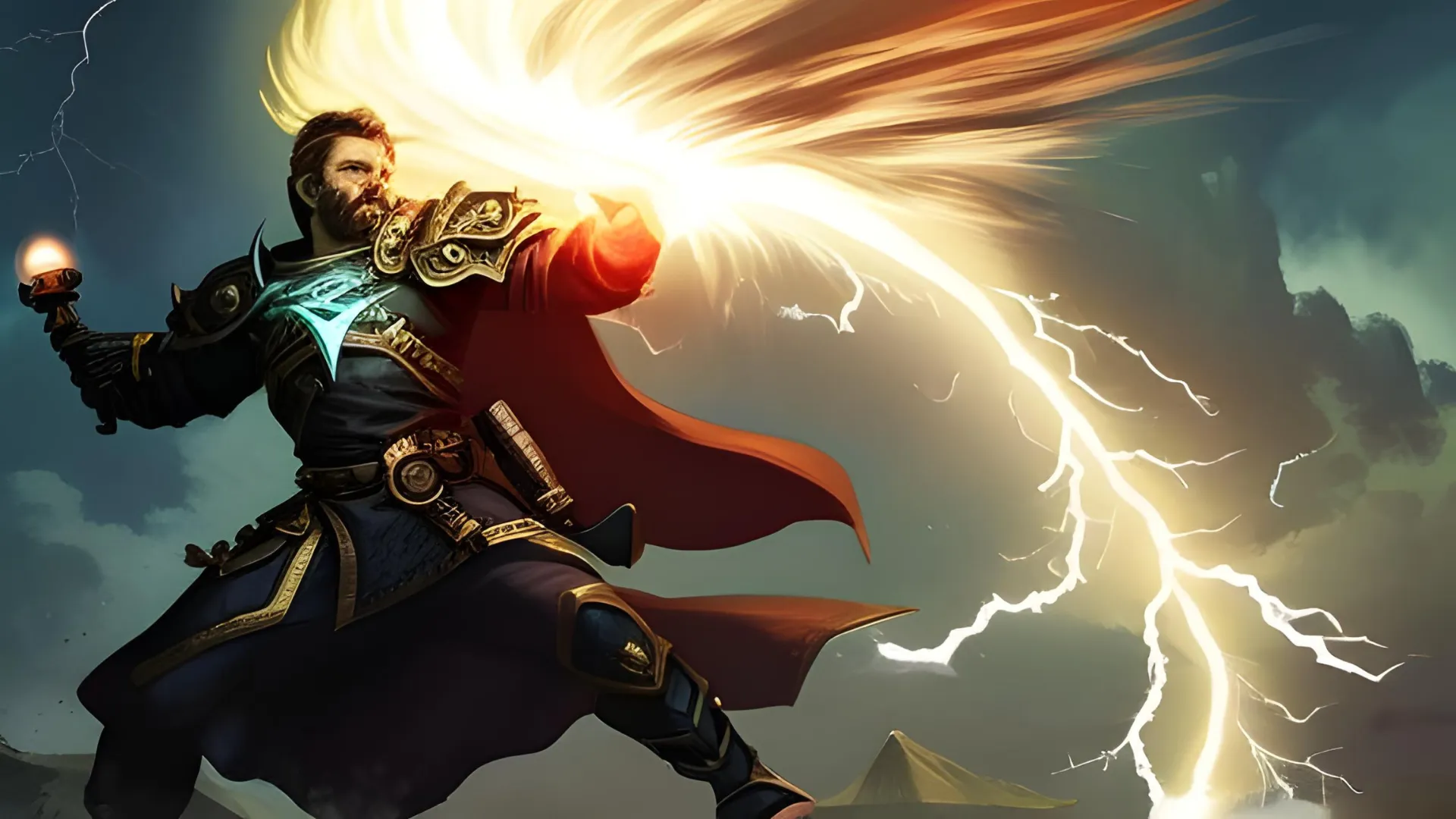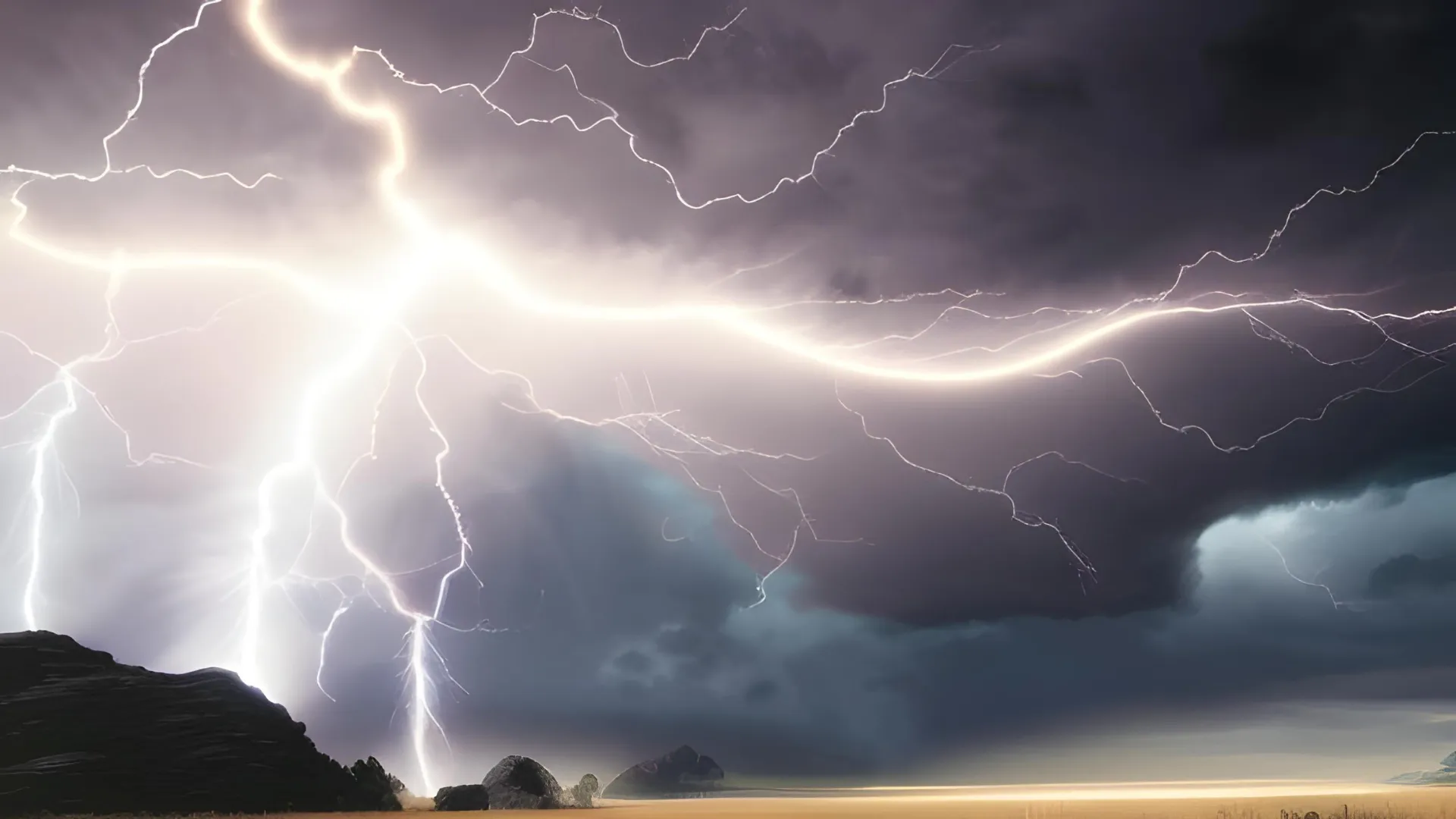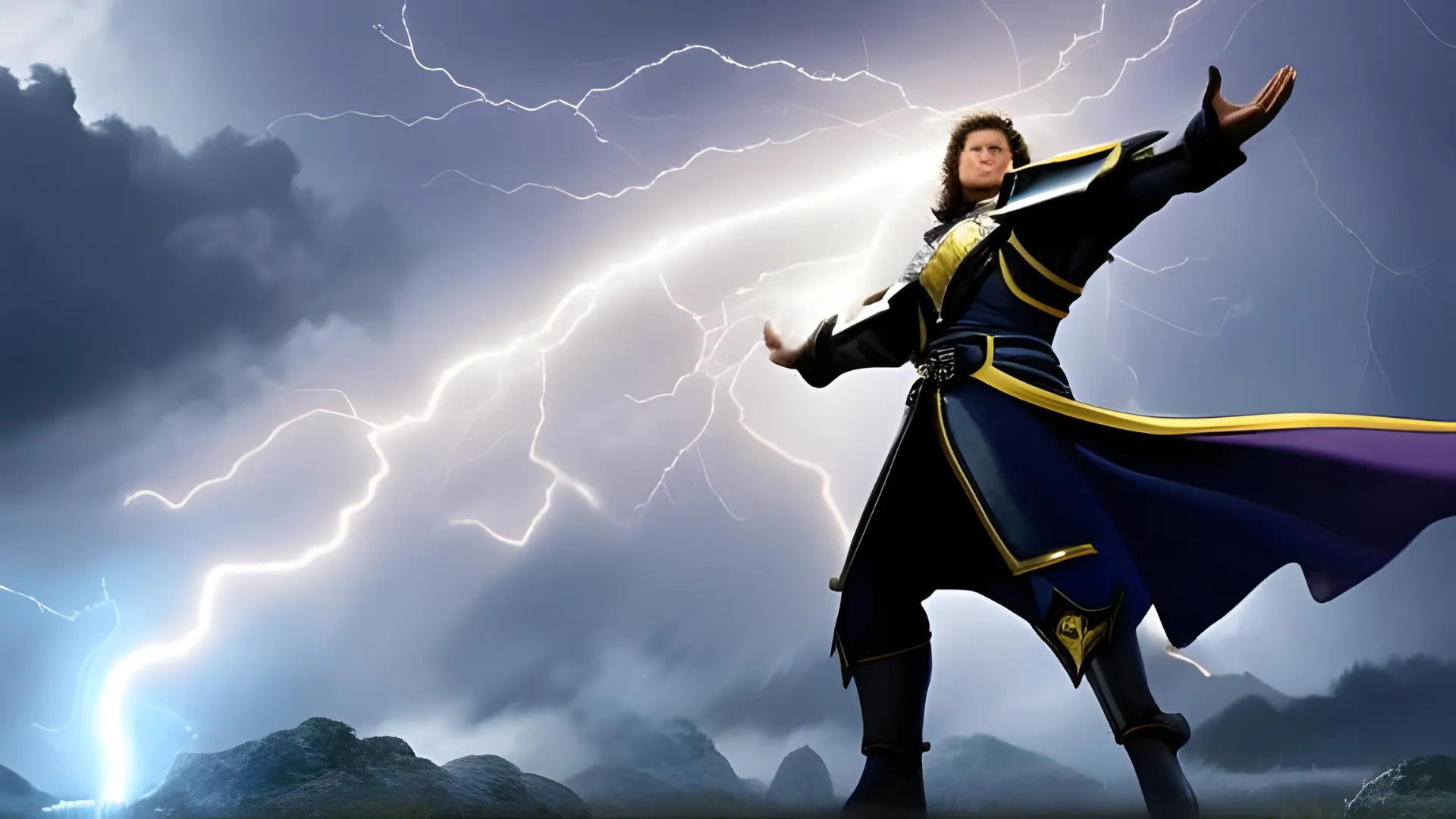Call Lightning is a spell in DnD 5e. It is a spell that allows the caster to summon the power of lightning and unleash it upon their enemies. When you cast this spell, you create a storm cloud in the air at a point you can see within range, which is typically 120 feet.
The storm cloud is a cylinder that is 10 feet tall with a 60-foot radius. Once the storm cloud is created, you can use your action on subsequent turns to call down a bolt of lightning from the cloud to strike a target within 5 feet of a point you choose.
The bolt of lightning deals damage to the target and any other creatures within a 5-foot radius of it. The spell’s damage increases as you cast it at higher levels, allowing you to channel even more powerful lightning.
Spell Mechanics
Call Lightning is a spell in DnD 5e that allows you to summon a storm cloud and call down bolts of lightning upon your enemies. The spell’s description and mechanics are as follows:
- Range: The range of Call Lightning is 120 feet. This means you can create the storm cloud at a point you can see within this range.
- Duration: The spell’s duration is concentration, up to 10 minutes. As long as you maintain concentration, the storm cloud remains active and you can continue to call down lightning bolts.
- Components: Call Lightning has somatic and verbal components, meaning you must make specific gestures and speak incantations to cast the spell.
- Damage and Area of Effect: When you cast Call Lightning, a storm cloud forms at the designated point. On subsequent turns, you can use your action to call down a bolt of lightning from the cloud.
The lightning bolt strikes a target of your choice within 5 feet of a point you select, and it also affects other creatures within a 5-foot radius of the target.
The damage dealt by the lightning bolt is 3d10 lightning damage on a failed Dexterity saving throw, or half as much damage on a successful save.
Preparing to Call the Storm
Preparing to wield Call Lightning as a druid in D&D 5e offers a range of options and synergies. Here’s what you need to know:
Choosing the Druid Class
Call Lightning is a spell commonly associated with druids. By choosing the druid class, you gain access to this spell through your class spell list. Druids have a natural affinity for nature and its elemental forces, making them ideal wielders of Call Lightning.
Multiclassing Options and Synergies
While Call Lightning is primarily associated with the druid class, multiclassing can provide additional options and synergies. For example:
Tempest Domain Cleric: Multiclassing into the Tempest Domain as a cleric can complement the lightning theme. The Tempest Domain offers abilities like Channel Divinity: Destructive Wrath, which maximizes lightning or thunder damage.
Storm Sorcerer: Multiclassing into the Storm Sorcerer subclass grants you access to additional lightning-themed spells and abilities. The Storm Sorcerer’s Heart of the Storm feature allows you to deal lightning damage to nearby foes when you’re hit by an attack.
Eldritch Knight or Arcane Trickster: If you choose the Eldritch Knight subclass as a fighter or the Arcane Trickster subclass as a rogue, you can learn to Call Lightning through the spellcasting feature gained at higher levels.
This allows you to combine lightning-based spellcasting with your martial or rogue abilities.
Required Spell Slots
To cast Call Lightning in DnD 5e, you need an available spell slot of 3rd level or higher. The spell slot’s level determines the damage the lightning bolt deals when you call it down.
If you have multiple spell slots of 3rd level or higher, you can cast Call Lightning multiple times or use those slots for other spells. As a druid, you prepare spells from your class spell list after a long rest.
To have Call Lightning available, you must choose it as one of your prepared spells. The number of spells you can prepare is based on your druid level and Wisdom modifier, as indicated in the Druid class features.
By choosing the druid class and potentially exploring multiclassing options, you can maximize the potential and versatility of Call Lightning, further enhancing your connection to the power of storms and lightning on the battlefield.
Connection in Druids and Lightning
Druids have a deep connection with the elemental forces of nature, including lightning. This connection stems from their attunement to the natural world and their ability to draw power from its primal forces.
Here’s a glimpse into the elemental lore and roleplaying opportunities associated with druids and their relationship with lightning:
Elemental Lore
Druids understand that lightning is a manifestation of raw elemental energy. It represents the power and fury of storms, the crackling force that can both destroy and renew.
They recognize lightning as a symbol of the untamed and unpredictable aspects of nature. Through their studies and communion with the natural world, druids learn to harness and channel this elemental force.
Roleplaying Opportunities
Embracing the connection between druids and lightning can offer exciting roleplaying opportunities. Here are a few ideas:
Reverence for Storms: Druids who wield Call Lightning often revere storms as sacred events. They might see themselves as conduits of the storm’s power and view lightning strikes as messages or blessings from nature itself.
Elemental Balance: Druids who specialize in lightning magic may have a particular affinity for the tempestuous aspects of nature. They understand that balance is crucial, recognizing that storms bring both destruction and renewal.
They may seek to restore harmony in areas where storms have caused the imbalance.
Weather Lore: Druids attuned to lightning develop a deep understanding of weather patterns and atmospheric phenomena. They might possess knowledge about the signs and symbols in the sky, allowing them to predict the coming of storms or other natural events.
Tapping into Primal Power
When a druid calls upon the power of lightning, they tap into the primal forces of the storm. This connection grants them the ability to channel and control the destructive might of lightning bolts.
The act of summoning lightning demonstrates their ability to commune with the elements, bridging the gap between the natural and magical realms.
By embracing the elemental forces, particularly lightning, druids can deepen their roleplaying experience, embodying the untamed and fierce aspects of nature.
Whether they seek to protect the balance of the natural world or unleash the fury of the storm against their enemies, druids who wield lightning magic demonstrate their profound understanding and mastery of the primal power within the elemental forces.
Casting Call Lightning Effectively
To cast Call Lightning effectively in D&D 5e, careful target selection, positioning strategies, and utilizing cover and terrain can greatly enhance your tactical advantage. Here are some tips:
Target Selection
When using Call Lightning, consider targeting clusters of enemies or areas where enemies are tightly grouped together. This allows you to maximize the spell’s area of effect, potentially damaging multiple foes with a single lightning bolt.
Aim for groups of enemies within 5 feet of each other to ensure the bolt affects as many targets as possible.
Positioning Strategies
Position yourself in a location that provides a good vantage point and maximizes the spell’s range. Being higher up, such as on a hill or rooftop, can broaden your line of sight and increase the chances of having suitable targets within range.
Try to position yourself in a central location where you have a clear view of the battlefield and potential targets.
Cover and Terrain
Utilize cover and terrain features to your advantage. Seek out vantage points that provide partial or full coverage while still maintaining visibility of the battlefield.
This allows you to reduce the chances of being targeted by enemies and provides protection when you’re concentrating on maintaining the spell. Be mindful of obstacles that might block the path of the lightning bolt, such as large structures or solid barriers.
Timing and Coordination
Coordinate with your allies to maximize the effectiveness of Call Lightning. Communicate your intentions and coordinate your actions to set up favorable situations.
For example, you can have your melee-focused allies engage enemies in close quarters, clustering them together for your Call Lightning strikes.
Environmental Factors
Pay attention to environmental factors that can enhance your Call Lightning abilities. If there’s a thunderstorm or inclement weather present, you may gain additional thematic and mechanical benefits when using lightning-based spells.
Work with your Dungeon Master to see if the environment provides any bonuses or advantages for casting Call Lightning.
Enhancing Lightning Strike
To enhance your lightning strikes while casting Call Lightning in D&D 5e, you can focus on spellcasting modifiers, increasing spell levels for greater damage, and combining the spell with other spells for devastating effects. Here’s how you can achieve that:
Spellcasting Modifiers
Your spellcasting ability modifier, typically Wisdom for druids, plays a crucial role in enhancing your lightning strikes. A higher ability score in your spellcasting modifier improves your chances of hitting with the spell.
To increase your spellcasting modifier, you can invest in increasing your Wisdom score through ability score improvements or magical items.
Spell Attack
When using Call Lightning, you make a spell attack to hit your target with the lightning bolt. Your spell attack bonus is your proficiency bonus plus your spellcasting modifier.
To enhance your spell attack, ensure your character has a high proficiency bonus by leveling up or multiclassing into classes that grant proficiency bonuses. Additionally, increase your spellcasting modifier as mentioned earlier.
Higher Spell Levels
Casting Call Lightning using higher-level spell slots increases its damage potential. By using a spell slot of 4th level or higher, the damage of the lightning bolt increases by 1d10 for each slot level above 3rd.
This allows you to channel even more devastating lightning strikes, making the spell more formidable against your enemies. Consider using higher-level spell slots when facing tougher foes or in critical moments.
Combining with Other Spells
You can combine Call Lightning with other spells to create devastating effects. For example:
Control Spells: Use spells like Entangle or Spike Growth to restrain or hinder your enemies’ movement. This forces them to stay within the area of effect, making them more susceptible to your Call Lightning strikes.
Area Denial Spells: Spells such as Fog Cloud or Sleet Storm can create difficult terrain or limit visibility, providing cover and making it harder for enemies to target you. This allows you to maintain concentration on Call Lightning while remaining protected.
Debuff Spells: Consider casting spells like Faerie Fire or Bane before using Call Lightning. These spells impose a disadvantage on saving throws or reduce enemies’ saving throw bonuses, increasing the likelihood of your lightning strikes dealing full damage.
Buff Spells: Enhance your spellcasting capabilities with spells like Bless or Enhance Ability. These spells can provide bonuses to attack rolls or saving throws, improving your chances of successfully hitting with Call Lightning or maintaining concentration.
Surviving the Storm
Surviving the storm while casting Call Lightning in D&D 5e requires protection, countering dispel and resistance effects, and maintaining concentration in combat. Here are some strategies to help you:
Protecting Yourself During Casting
When casting Call Lightning, it’s important to prioritize your own safety. Seek cover behind obstacles or structures that can shield you from enemy attacks. By positioning yourself strategically, you can reduce the chances of being targeted.
Defensive spells like Barkskin or Shield of Faith can also provide additional protection by increasing your Armor Class or granting temporary hit points. Remaining mobile and maneuvering around the battlefield can help you stay out of harm’s way while maintaining concentration on the spell.
Countering Common Dispel
Certain creatures may possess resistance or immunity to lightning damage, which can diminish the effectiveness of Call Lightning. To counter this, consider using spells like Elemental Bane or Elemental Weapon to change the damage type or bypass resistance.
These spells allow you to adapt to different enemy resistances and deal full damage. Additionally, be prepared for opponents who might attempt to dispel or interrupt your Call Lightning spell.
Having the counterspell spell prepared allows you to react and counter their attempts, preserving your spellcasting efforts.
Maintaining concentration in combat
Concentration is crucial for sustaining the powerful effects of Call Lightning. To maintain concentration, enhance your concentration checks by increasing your Constitution score or using spells like Enhance Ability (Bear’s Endurance) or the War Caster feat.
These options improve your chances of successfully maintaining concentration, even when taking damage. Additionally, staying out of harm’s way by strategically positioning yourself and utilizing cover can minimize the chances of being hit and losing concentration.
Seek support from your allies, who can provide assistance in protecting you, drawing attention away from you, or casting spells like Aid or Heroism that can grant temporary hit points or bolster your concentration checks.
Mastering Call Lightning
Mastering Call Lightning in D&D 5e involves advanced tactics such as predicting weather conditions, battlefield manipulation, and coordinating with party members for synergistic strategies.
These tactics can elevate your effectiveness in combat. Here’s a breakdown of each tactic:
Predicting Weather Conditions
As a druid attuned to nature, you can use your knowledge of weather patterns and natural phenomena to predict optimal conditions for casting Call Lightning. Keep an eye on your surroundings and communicate with your Dungeon Master about the current or upcoming weather.
Thunderstorms or other weather disturbances can enhance your lightning-based spells. Plan your encounters accordingly, aiming to cast Call Lightning during stormy or overcast conditions for maximum impact and thematic immersion.
Battlefield Manipulation
Call Lightning is more than just a damage-dealing spell. It can also be used for battlefield manipulation. Take advantage of its area of effect and the threat it poses to enemies to influence their movements.
Use Call Lightning strategically to force enemies into advantageous positions or to discourage them from occupying specific areas of the battlefield. By creating a hazardous zone with consistent lightning strikes.
You can control the flow of battle and limit the options available to your foes.
Coordinating with Party Members
Coordinate with your party members to create synergistic strategies that complement Call Lightning. Here are a few examples:
Tank and Spank: Position a melee-focused ally as a “tank” in close proximity to enemies, drawing their attention and clustering them together. This allows you to unleash devastating Call Lightning strikes that affect multiple targets.
Area Control: Have your spellcasting allies cast spells like Wall of Fire or Web to restrict enemy movement and keep them within the area of effect of your Call Lightning. This synergistic approach amplifies the damage potential and ensures maximum efficiency.
Debuff and Strike: Coordinate with party members who can apply debuffs or impose conditions on enemies, such as casting spells like Hold Person or imposing the restrained condition.
This increases the likelihood of your lightning strikes dealing full damage, enhancing overall effectiveness.
Lightning Spells and Synergies
Lightning spells in D&D 5e can be incredibly potent, and when combined with synergistic strategies, they can unleash devastating effects on the battlefield. Here are some notable lightning spells and potential synergies:
Call Lightning
Call Lightning allows you to channel the power of a storm and strike your enemies with bolts of lightning in DnD 5e.
Synergies with this spell involve coordinating with allies to control the battlefield and maximize its effectiveness, such as using area control spells or creating clusters of enemies for multiple lightning strikes.
Chain Lightning
Chain Lightning is a high-level spell that releases a bolt of lightning that jumps between multiple targets. This spell is particularly effective against groups of enemies, allowing you to hit multiple foes with a single casting.
Synergize with abilities or spells that enhance the spell’s damage, such as the Empowered Evocation feature of an Evocation Wizard or the Storm Sorcerer’s Storm Guide ability.
Lightning Bolt
Lightning Bolt releases a line of lightning, damaging all creatures in its path. It’s an excellent spell for dealing with enemies in a straight line, such as those standing in a narrow corridor or a tightly packed formation.
Combine it with spells that create barriers or obstacles to manipulate enemy movement, forcing them into positions where they are vulnerable to the lightning bolt’s path.
Storm Sphere
Storm Sphere creates a swirling sphere of elemental energy, including lightning. This spell not only deals lightning damage to creatures within its area of effect but also provides additional benefits such as granting advantage on spell attacks and imposing penalties on enemy saving throws.
Combine it with spells that restrain or hinder enemy movement, forcing them to stay within the sphere and suffer its damaging effects.
Thunderwave
Although not a direct lightning spell, Thunderwave releases a powerful wave of thunderous force that can push enemies away and deal damage.
It can synergize well with lightning spells by positioning enemies in favorable positions for subsequent lightning attacks or creating opportunities for movement manipulation.
Homebrew Options
There are various homebrew options and variants for the Call Lightning spell in DnD 5e. While homebrew content is not officially supported and should be approved by your Dungeon Master, here are a few examples of Call Lightning variants that you might consider:
Elemental Call
This variant allows you to choose a different element instead of lightning. You can customize Call Lightning to evoke elemental forces such as fire, cold, or acid, depending on the theme of your character or campaign setting.
The damage type and visual effects of the spell would change accordingly.
Storm caller’s Fury
This homebrew option enhances the base Call Lightning spell by increasing its damage output or providing additional effects.
For example, you might add the ability to cast the spell at a higher level, increasing the number of bolts or the damage dice, or allowing the lightning strikes to jump to additional targets within a certain range.
Chain Storm
This variant modifies Call Lightning to create a chain reaction effect. Instead of targeting a single point, the lightning bolt jumps from one target to another within a specified range.
This allows you to hit multiple enemies with each bolt, potentially affecting a larger area and causing widespread damage.
Storm’s Embrace
This homebrew option introduces a unique feature to Call Lightning, such as granting temporary hit points or imposing conditions on affected creatures.
For example, each successful lightning strike could grant temporary hit points to you or your allies within the spell’s radius, providing additional survivability in combat.
Storm Mastery
This variant focuses on enhancing the control and manipulation aspects of Call Lightning. It could allow you to shape the path of the lightning bolts, guiding them around obstacles or adjusting their trajectory to strike specific targets.
This provides more tactical flexibility and increases your ability to hit enemies with precision.










